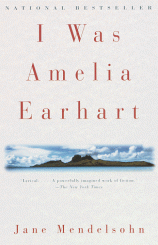About the Book
About the Book
I Was Amelia Earhart

Jane Mendelsohn has revisited the mystery of Amelia Earhart's legendary final flight, to continue the story from the glorious windy day when Earhart and her navigator disappeared into history somewhere over the mid-Pacific.
In this novel, charged with lyricism and longing, Amelia Earhart returns to life to tell us about her childhood, her marriage, her overexposed public life, and her eventual fate: marooned on a tiny island and lost to the world, she and her navigator find themselves living an adventure that even the world-famous heroine had never dreamt of.
Amelia Earhart
While it is a brilliantly imagined meditation on the "afterlife" of its famous subject, Jane Mendelsohn's novel is based closely upon the facts of Amelia Earhart's life and the circumstances of her last flight. Its immediate inspiration came from a report by Richard Gillespie, published in Life magazine in April 1992, that he had found evidence that Earhart and her navigator, Fred Noonan, had landed on an island called Nikumaroro, 350 miles south of their intended destination.
On the morning of the second of July, 1937, Amelia Earhart took off from Lae, New Guinea, en route to Howland Island, a tiny stopping point in the mid-Pacific. She, Noonan, and her twin-engine Lockheed Electra were never seen again. This was her second attempt at an around-the-world flight, and she was only 7000 miles short of completion of her equatorial route. Although Fred Noonan was an excellent navigator, he had been fired by Pan Am for drinking, and during the flight Earhart reported "personnel problems" to her husband. In addition, Earhart had decided to drop the trailing antenna for her direction finder, and to leave behind in Miami her telegraph code key transmitter, for neither she nor Noonan knew Morse code. These decisions effectively cut them off from all but radio contact, and Earhart was often lax about giving position reports by radio. Only seven position reports were radioed by Earhart during their entire trip. Born in Atchison, Kansas, in 1897, Amelia Earhart was hooked on aviation after her first flight in 1920. She became a media celebrity in June 1928 when, at the invitation of George Palmer Putnam, the publisher of Charles Lindbergh's We, she became the first woman to fly across the Atlantic (though, to her chagrin, as a passenger). Putnam created another instant bestseller when he issued the story of her flight. Shortly afterward, Putnam divorced his wife and married Earhart; he then became very much involved in promoting her career and generating publicity around her. He has been criticized for his single-minded pursuit of fame and money at the risk of his wife's safety.
Earhart was a committed feminist and a friend of Eleanor Roosevelt. At the time of her disappearance, she was about to give up "stunt flying" in order to pursue flight research at Purdue University. In the sixty years since her disappearance, the mystery of Earhart's fate has provoked an enormous amount of both speculation and scientific inquiry, but nothing conclusive has ever been determined.
I Was Amelia Earhart
- Publication Date: March 4, 1997
- Paperback: 160 pages
- Publisher: Vintage
- ISBN-10: 0679776362
- ISBN-13: 9780679776369








